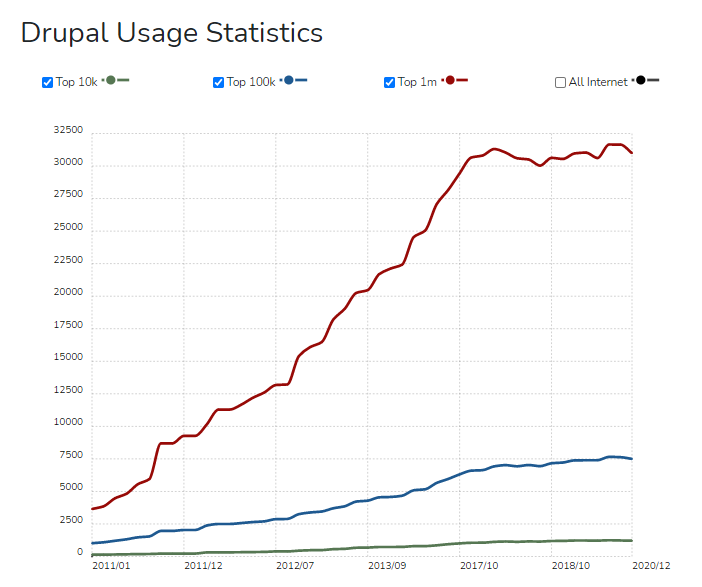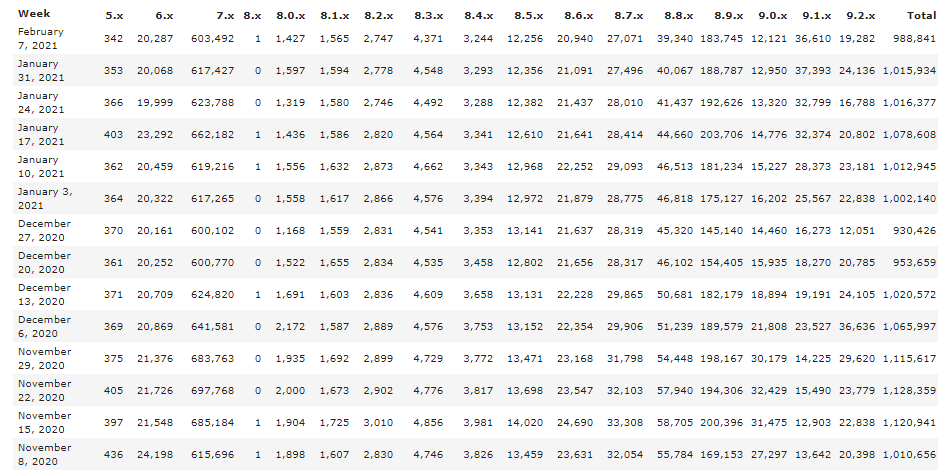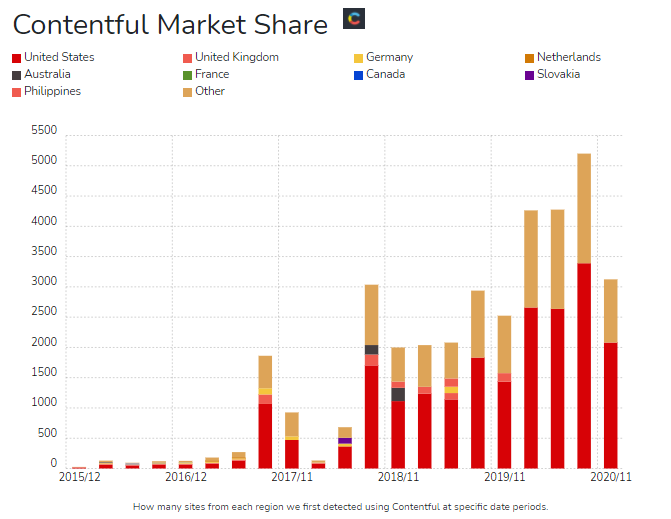Gurpreet Kaur
Mon, 02/22/2021 – 16:16
All the advantages that we are able to reap from the online world, from the websites we so eagerly use, are dependent on a particular system. This is the system that they are built on, the more versatile it is, the better the website’s versatility is going to be. And this is exactly what we expect from our web experiences and the system provides almost every time.

It is the Content Management Software, I am raving about. There are plenty available for the developers to choose from. However, we’ll be talking about two of them in particular, comparing them actually as they are strangely a bit alike and a bit different too. These are Drupal and Contentful. So, let’s begin.
| Parameter | Drupal | Contentful |
| Market Share | Founded in 2000, Drupal has a substantial market presence, with a million sites using it | Launched in 2013, Contentful’s market share is impressive too |
| Decoupled Architecture | Drupal offers efficient decoupling with an API-first infrastructure | Decoupling features are similar to Drupal |
| Performance and Scalability | If optimised properly, Drupal provides impeccable performance and limitless scalability | Contentful offers great performance too, however, it poses technical limitations |
| Security | Quite reliable and the most secure open source CMS with a proactive community constantly working on issues | Good, however, bugs can be a common occurrence |
| Content Workflow | The content modelling and editorial experience is wholesome for the authors, Views system being the highlight | Contentful works differently, but offers an equally wholesome experience to content authors |
| Pricing | Free to install and configure, there can be other costs depending on the scale of the project | Not free, being a proprietary software, has a standard monthly cost to be paid |
| Third-party Integrations | Integrates seamlessly with third party tools and application | Matches Drupal in this regard |
| Community | The Drupal community is over a million and growing | Contentful does not have such a wide community, but its Community Plan is a step towards it |
| Migrations | Difficult in the past, but a breeze with the launch of Drupal 9 | The CLI tool helps in migrations, making them automated |
| Responsiveness | Designs, themes, images and tables, everything is mobile-friendly with Drupal | The responsiveness to mobile devices is quite impressive as well. |
| Multilingual | Translates content, configurations and interfaces in over 90 languages | Offers translation services similar to Drupal, but in 30 languages |
| Accessibility | Drupal follows WCAG 2.0 and ATAG 2.0 guidelines for accessibility | Contentful follows WCAG 2.1 guidelines |
| SEO | Drupal has a module for every SEO need, be it keywords or links | Contentful also supplements SEO needs, but it is dependent on the creation of dedicated content types |
Understanding the CMSs and their abilities
Drupal, leading as an open source
Drupal has been around for two decades. The 15th of January 2021, marked its 20th birthday, being around for this long, it has mastered all the nuances of content management and digital experiences. It is a digital experience management system that has the potential of driving web content onto multiple platforms to provide personalised experiences that would allow your users to connect with your organisation.
The kind of content management tools Drupal comes with are not only sophisticated, but also stimulate perpetual innovation. The great thing about Drupal isn’t its numerous modules, themes and templates, even though they are great too, but it is the fact that Drupal is open source and accessible to far more people than a proprietary software would be.


Contentful, not the conventional CMS
Contentful was founded in 2013 by Sascha Konietzke and Paolo Negri in Berlin. It hasn’t been around as long as Drupal, but it isn’t the new kid on the block as well. In simple terms, Contentful is a content infrastructure, a platform that would allow you to create, manage and distribute content to any platform.
This pretty much sums up the definition of a CMS. So, why did I say Contentful was not conventional?
Other CMSs, Drupal included, come with out-of-the-box content models that you have to choose from. However, with Contentful you have the liberty to create your own content models and you get to decide which content you want to manage. The RESTful APIs provide you the ability to deliver your content across multiple platforms, including websites, mobile apps, be it iOS, Android or Windows. From Google Glass to infinity, it is your pick. You can utilise the potential of Contentful on your own or a team. The uncluttered UI makes assigning custom roles and permissions a breeze. Contentful is a modern content platform that paves the way for faster launches.

Drupal vs Contentful: Putting them under the microscope
How efficient is decoupling?
Usually a CMS is equipped to manage content in the backend and push it to the front-end templates that essentially provide the desired user experience. This meant that a CMS served as an all-in-one system that provided for all the development needs. However, that is changing with decoupling, where-in the frontend and the backend are two different entities, independent of each other.
Drupal
With Drupal, you can decouple the frontend from the backend where you want to, making the content become reusable chunks that are independent of the presentation layer and always prepared for delivery to as many sites and apps.
When you decouple, you get the benefit of Drupal’s presentation-neutral content. The REST API, GraphQL, JSON:API and all the different alternatives that you get in decoupled Drupal ecosystem to build a front-end as you want, with any technology you want, is amazing
These are a few of the tools and frameworks that decoupling Drupal would allow you to take up and build interactive sites and apps. You can get the complete insights on what frontend technology to use with decoupled Drupal architecture here.
You also get the opportunity to future-proof your project by refreshing designs without re-implementing the entirety of the CMS.
Contentful
Since decoupling is dependent on one principle, that is the separation of the frontend from the backend, I wouldn’t say that Contentful is all that different from Drupal in this regard.
- It is an API-first content infrastructure.
- It makes front-end layers less rigid and more versatile, with a number of tools and frameworks.
- It acts as a content repository delivering your content.
All of this is achievable through Drupal as well. What is different are two things;
- It has its own Contentful API, delivered through a CDN, while Drupal operates on RESTful APIs, JSON and GraphQL.
- Next is the fact that Contentful uses an approach known as JAMstack, JavaScript, APIs and Markup; while decoupled Drupal uses MERN, MangoDB, Express, React, NodeJS.
There are also chances of API requests turning wrong. When that happens, the Contentful server will automatically create an error, with an appropriate HTTP status code in the header along with a JSON response in the body.
How reliable is the performance and scalability?
Drupal
Drupal comes equipped to handle any and all performance scalability needs an organisation might have. However, it would only be able to do that if you optimise it properly, that is a contingent for scalability.
For instance, sites operating on Drupal 8 and later versions come with tools that will allow you to scale on the frontend and the backend.
Blazy
Content Delivery Network
Server Scaling
Site Monitoring tools
All account for a better performing Drupal site that is always ready to accommodate for traffic spikes and content growth making your site always available. To know more, read these comprehensive guides to Drupal performance optimisation techniques and scalability provisions.
Contentful
Contentful was made to scale to compensate for your site’s growth much like Drupal. It has taken into consideration all of the dimensions of growth that a site or app may face and categorised them into seven categories.
It is prepared to handle
- heightened levels of traffic, data and usage;
- the addition of more projects, products and channels;
- an increased level of complexity and sophistication in use cases;
- an expansion in global markets;
- an elevated number of internal users;
- an enhanced pace of development;
- and cater for an advanced level of security for business perpetuity.
At the end of it all, Contentful comes with certain technical limits upon the infrastructure. These are enforced to mandate a lack of interruption on the shared-service infrastructure functions, however, they are limits all the same. Reading them before using Contentful would be wise.
How sufficient is the security?
Drupal
In terms of security, Drupal is on the higher level of sufficiency, if not the best. The kind of features it comes equipped with make it a frontrunner. A Sucuri’s report even showed that Drupal is amongst the most secure open source CMS out there.
Drupal security is very competent because of;
- Its expert security team, adhering to the guidelines set by Open Web Application Security Project;
- Its community, being proactive and analysing any security issues;
- Its implementation of a secure access through strong passwords that are even encrypted;
- Its secure codebase;
- Its control over the most trivial user access;
- Its encrypted database;
- Its APIs, ensuring validation of data and preventing malicious entry.
Contentful
Contentful almost competes with Drupal in terms of security, I have used the term almost because there is a catch.
Talking about the positives, Contentful’s security infrastructure is based on Amazon Web Services, making it quite impressive.
- It has ISO 27001 compliant data centres;
- It comes with data storage, that is encrypted at rest along with an encryption of all forms of communication in transit;
- It comes handy with a web application firewall, brute force prevention, data retention policy, threat detection and two-factor authentication along with security audits.
Despite all of these measures, Contentful isn’t totally secure from hacks. There are bugs and fixes that are often highlighted, and with a large codebase like that of Contentful, it is almost understandable. Therefore, its Bug Bounty Program was launched to reward hackers for finding these issues and vulnerabilities.
How streamlined is the content workflow?
For a content management system, the content is the most essential part, its creation and management to be streamlined for the CMS to be successful.
Drupal
In terms of content modelling and the editorial experience, Drupal’s abilities are more than impressive.
- Drupal offers numerous field types like boolean, comments, date, email, links, timestamp and numbers, inclusive of decimals, integers and floats.
- Drupal’s Field Group module enables you to custom group fields, allowing easy customisations for your editors.
- The Views system helps in creating an experience that has enhanced uniqueness because it gives you the power to add any field to the view, pull relationships as well as executing many operations at once.
- Then there is the Content Moderation module along with the Workflows module that can define an innumerable count of arbitrary publishing states and workflows. You could have a largely diverse team, and still be able to map out your preferred workflow before implementing it.
Majority of these are unfound in Contentful, however, it does have its own share of tools accounting for a streamlined workflow.
Contentful
Contentful doesn’t really fall behind Drupal in content workflow by a substantial margin. Its abilities are almost as good as that of Drupal’s. Contentful’s default editorial experience is extremely easy to understand and use. However, when you decouple it, say using React, you would have to part with the default features.
- Contentful offers field types as many as Drupal’s, however, it doesn’t highlight specific format types like email and links and physical addresses. But then it has a JSON object, which Drupal is missing out on.
- Contentful uses widgets to define each field type.
- Default content views make viewing and filtering content very easy.
- Contentful also has easy field restoration with a referencing experience for searching and creation of entities, both of which aren’t found in Drupal.
Contentful’s content modeling and editorial workflow are quite different from Drupal, but effective all the same.
How pocket friendly is the pricing?
Drupal
Being an open source software, Drupal is free to install and configure. If you have the right human resources, it is absolutely free. However, if you don’t, then it is going to cost you. And these costs depend on the kind of site you are building.
Costs would be dependent on;
- The size of the site you are aiming for, the bigger the project, the higher the cost;
- The kind of complexity it is going to mandate in relation to workflows, integration and multilingual sites;
- The timeline and the team you would be relying on; a bigger project would need additional team members like project managers and quality assurance personnel;
- Then there is the question of the Drupal agency to do all of this for you, if you cannot, which is going to cost you.
Contentful
Contentful isn’t associated with being free like Drupal. It has different pricing models for different needs of developers and organisations.
- If you are looking to build a personal site as an individual developer, Contentful would be free for you.
- If you are looking to power a modern stack site or two with enhanced authoring roles and technical support, you could take up a free trial and then subscribe to Contentful starting at $489 per month.
- And if you are looking to build hundreds of digital experiences while scaling your content platform, you can get a custom plan from Contentful for your specific needs.
I wouldn’t say Contentful is too heavy on the pocket as is, but including the cost of hiring developers and staff and it would become more expensive than Drupal.
How effective are the third party integrations?
Drupal
Drupal is renowned for its abilities to integrate itself with third party tools and applications. Be it analytic platforms, e-commerce verticals, ERP systems or email and marketing systems, Drupal works well with all of them.
Its API-first focus, like Contentful, makes it essential for finding connections to make content reach to other sites and apps. And third-party integrations are just the way to do that.
Contentful
Contentful comes with UI extensions that are able to integrate themselves with external APIs and third party data. From e-commerce sites to YouTube to local translators, Contentful can merge itself with a number of tools.
There is also the fact that Contentful has successfully integrated itself with Gatsby and Metalsmith as its official projects proving its abilities further in this regard. Drupal and Contentful aren’t all that different in terms of third party integrations.
How helpful is the community?
Drupal
Drupal is a large platform, operational all over the globe. This means that its community is also spread throughout the world. And it has, the Drupal community has over a million users in as many as 230 countries, isn’t that an achievement in itself?
People from different backgrounds, different skill sets and different perspectives come together to improve Drupal and enhance its community ties. Perks of contributing to open source are immense and this guide to Drupal contribution will shed more light on the advantages that you get.
Contentful
Contentful does not have a community as wide as Drupal’s. However, it is making strides towards building one. It has devised and launched a Community Plan that would empower individual developers to build as they like, without incurring any costs as opposed to its 14-day free trial.
The community also provides technical support through its slack channel, where thousands of developers are active and ready to help.
How seamless are the migrations?
Upgrades and migrations are inevitable when it comes to web development. Usually developers do not look forward to the hassle they bring along. So, do Drupal and Contentful bring on the hassle or eliminate it?
Drupal
With Drupal 9 having launched last year and Drupal 10 on the horizon, there is a lot of anxiety amongst the Drupal 7 and 8 using folks. The primary reason for the anxiety being the looming EOL dates and the heavy-duty upgrades.
However, the anxiety isn’t necessary at all.
Talking about the switch from Drupal 8 to 9, as per the makers, this upgrade is considered the easiest in almost a decade. By following a four-step guide, you can have your current site ready for the functionality and better security standards of Drupal 9 by using the Upgrade Status.
As for the upgrade from Drupal 7 to 9, easy is not a term that would be used to describe it. The migration will overwhelm you, but all the advantages of Drupal 9 will make it seem worth it. Developers can make the upgrade themselves with the help of Upgrade Status and Drupal Module Upgrader. These help in letting you know whether your themes and modules are competent for Drupal 8/9 and converting your custom code respectively. Explore the ultimate guide to Drupal 9, all the burning questions that you may have about Drupal 9 and the must-have modules to start your Drupal 9 website to know more.
Contentful
Contentful has a tool that helps in the migration process, making it rather easy by using CLI. The Contentful migration CLI helps developers to script changes to the content model with a fine-tuning that wasn’t possible before. Using continuous integration services along with it will also help you in validating the deployment before it hits production.
Installation and configuration of the Contentful CLI;
Writing of your own migration script;
And applying the migration with CLI, is all you need to do to make it happen.
The result would be getting documented and versioned content types along with automated and predictable migrations that can be repeated in other environments.
How versatile is the responsiveness?
Drupal
In terms of responsiveness to devices, Drupal is a pro. Providing an optimal visitor experience is one such feature of Drupal that makes it worth everyone’s while and responsiveness is its core.
Drupal offers;
- Responsive designs;
- Responsive themes;
- Responsive images and breakpoints;
- And even responsive tables;
All of these enable Drupal sites and apps to identify the width and height of any device and adapt itself accordingly, making it mobile and user-friendly at the same time.
Contentful
Contentful is often referred to as a mobile content management system, meaning it was built keeping in mind the fact that developers and authors would want to publish content on the go through a smartphone or tablet and Contentful makes that work seamlessly.
It optimises mobile performance with three features;
- Selective sync;
- Image auto-compression;
- And providing support for offline persistence.
This makes it as good as Drupal in responsiveness.
How fluent are the multilingual sites?
Drupal
Another one of the benefits of Drupal is the fact that it caters to a multilingual audience very well. With inbuilt language handling abilities, it provides localised digital experiences that are both fast and easy to get.
- It can translate content, configurations and interfaces.
- It can be run in 90+ languages.
- It also provides an overview screen for translators, making their work easier.
Access this guide to Drupal’s multilingual capabilities to know more.
Contentful
Much like Drupal, translations in Contentful also take place in-house. It has a six-step process to make translations happen, which isn’t very complex or rigid. You can add and delete the locales (languages) from the settings as and when you wish, provided you have administrative access.
The only aspect that pales Contentful in front of Drupal is the number of languages supported. Sadly, Contentful only offers translations in 30 languages.
Contentful uses locales to define the varying languages a site might use. This allows you to define localisations of content easily enough. However, when you have to work with multiple locales, it can become confusing for your authors. That being said it is an insurmountable task, organisations have worked with as many as 30 locales at once.
How universal is the accessibility?
Drupal
Drupal follows the WCAG 2.0 and ATAG 2.0 guidelines to make its projects accessible to people with disabilities.
Features for screen readers are a major part of it, with the inclusion of drag and drop functionality, colour contrast, image handling, form labeling and exclusion of null tags, to name a few.
Drupal accessibility also transcends from the users to the developers, with themes, modules and community sites making an inclusive developer environment.
Contentful
Contentful also offers similar features and functionalities for accessibility like Drupal. The only major difference is that it adheres to WCAG 2.1 guidelines, which are more recent.
Building sites that are easy to adapt, navigate, have distinguishable elements and are keyboard accessible are some of Contentful’s accessibility principles. It also implements automated accessibility testing to check whether the project is compliant with the set standards or not.
How friendly is the SEO?
Drupal
Drupal has powerful SEO tools that can enhance your site’s visibility by a landslide. When I say tools, I mean modules, the use of which can make you a pro at SEO.
Mastering the keyword game through Real-time SEO for Drupal;
Mastering the linking game through Linkit module;
Mastering the duplicacy predicament through Redirect module;
Drupal can and will keep you at your A-game in terms of SEO. The Ultimate Drupal SEO Guide will help you become acquainted with all the right SEO modules.
Contentful
When you use Contentful as is, there aren’t as many SEO privileges to enjoy. For instance, a media page would only have a title and a description. That’s not to say that Contentful doesn’t provide for SEO.
It does, however, for that you would need to provide more information. This means you would need to create a dedicated content type for the media files you will have.
Once that is done, you Contentful will enable you to;
- Take command of the SEO;
- Put in the right tags (which are only used for organising and searching content, sadly);
- And add alt text for your accessibility.
The change in the content type helps you to create whatever suits your needs and preferences, which is a good thing. There is one thing to remember that the extended metadata for these media files would be stored in the content tab, rather than the media tab, where the actual file would be located. This can be a little confusing.
The bottom line
In the end, I wouldn’t say one is definitely better than the other. There are aspects wherein Drupal prevails over Contentful, like security and performance; however, there were also areas, wherein Contentful gave Drupal a run for its money, like accessibility and responsiveness. I’d say that both are great at what they do and saying one is entirely better than the other wouldn’t be appropriate. So, I’ll leave it to you.

